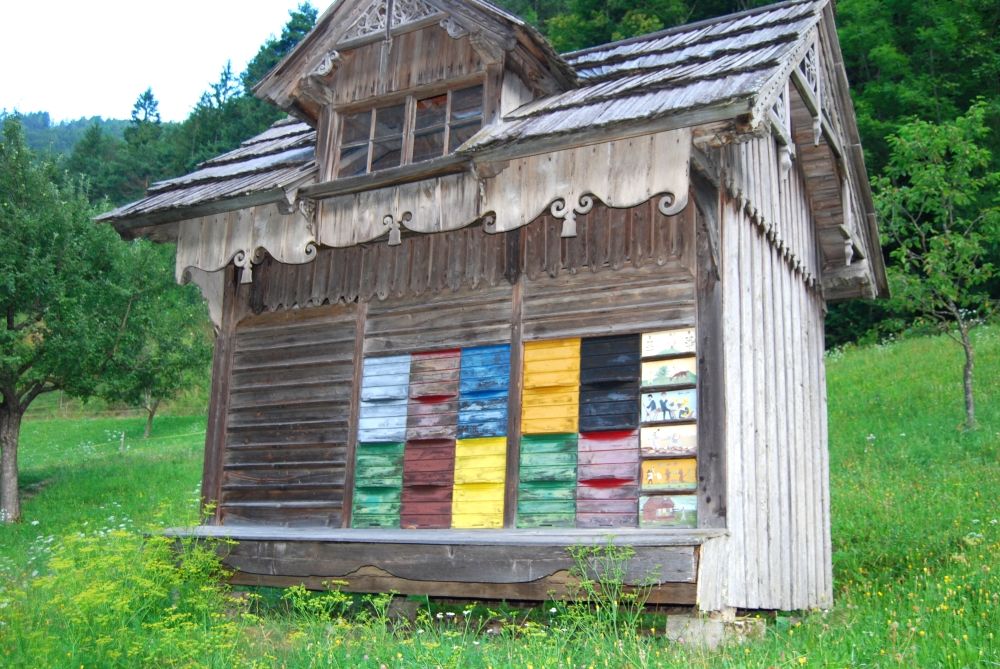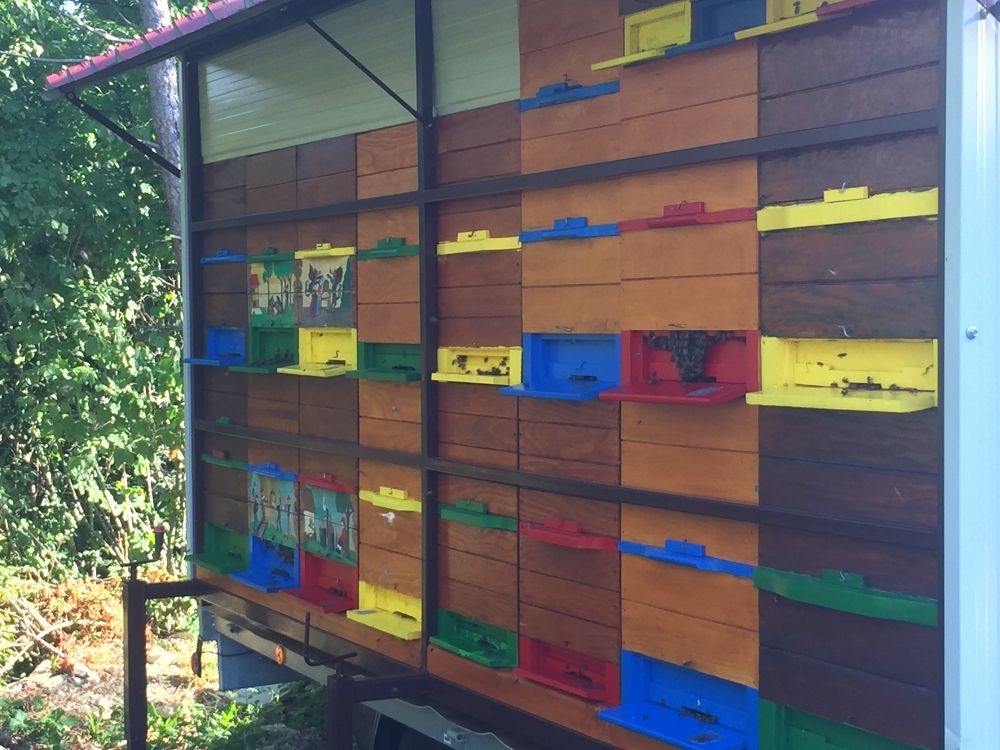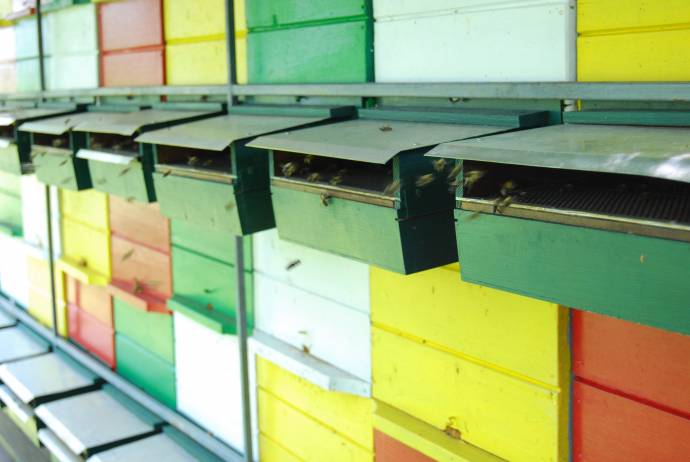April 29, 2018
Jay Ebben is an Associate Professor of Entrepreneurship at the University of St. Thomas in St. Paul, Minnesota. He and his family lived in Slovenia for five months in 2011 and they have returned five times since. His experiences in Slovenia inspired him to write Painted Hives, a novel about a boy who travels to Ljubljana to take a beekeeping class.

Part 2: Why Beekeeping?
When we first arrived in Ljubljana in 2011, I knew absolutely nothing about bees. I didn’t know that there was a difference between honey bees and other bees, or that there were different types of honey bees. I didn’t even know that there were different types of honey – I thought honey was honey and that all of it came in squeezable plastic bottles in the shape of a bear. But, as I imagine many American visitors experience, it’s difficult to spend time in Slovenia without learning at least a few things about bees.
My first education came when we walked into the Honey House that February, which was just a few doors down from our apartment on Mestni trg (aka Town Square). It was a tiny store, with products neatly laid out on shelves and samples on a table near the door. It must have been obvious that we weren’t locals, because the twenty-something woman in the store said, “Welcome to the Honey House, would you like to try something?” in perfect English.
There were four or five types of honey on the table, acacia and linden and a few others, and she explained that honey that comes from the nectar of different flowers tastes very different (which seemed like something I should have known). So, she told us, beekeepers harvest honey after each flower blooms to get these pure varieties (which also seemed logical).
“Here, try this,” she said, smiling, handing my wife and I small plastic sticks with a smudge of dark honey on the end. It was chestnut honey, and it was bitter as could be, the exact opposite of what you think of when you think of honey. “And now this, it’s acacia” she said, handing us each another stick. It was unbelievably sweet and light and smooth, and it immediately became my personal favorite.
The woman then showed us every other product in the store that came from bees and told us why we would want to buy each one: pollen, propolis, royal jelly, honeycomb, honey liquor, some concoction that was a miracle cure for sore throats, and more. She also pointed out the painted beehive panels on the wall and explained how painting scenes on beehives was a tradition unique to Slovenia and was supposed to bring the bees good luck.
I think we bought one of everything in the store, and I started taking pollen and supermix every day, and eating acacia honey by the kilo (the list of foods that taste better with it is endless). It was my own version of apitherapy, and I loved it.

But I didn’t become truly obsessed until we visited a bee farm in early May. A women’s group my wife had joined had organized a trip to visit a beekeeper, so one Saturday morning we piled into the beat-up Renault Megane station wagon we used to get around and headed out to a picturesque little village near the Italian border.
Our beekeeper host, Frank, toured us around his property just outside the village, explaining his strategy for planting flowering trees, moving his bees to different locations, and so on, all to keep his bees “happy”. He had been keeping bees for over fifty years and had cultivated the property to be the perfect environment for them (and to be absolutely beautiful as well).
Then he stood in front of his beehouse in the midst of a cloud of bees that were taking off and landing, and he told us what seemed like everything there was to know about keeping bees. He showed us how he collects pollen from the bees and how he “tricks” them into filling up a screen with propolis, talked about swarms and splitting hives, and he enthusiastically gave us the rundown of all the health benefits of bee-related products. “I am trying to come up with a way to mass-produce dental floss with propolis,” he told us. “Propolis is great for gum health. I’ve been putting it on my own dental floss for years.”
There was also a small cabin on the property, where Frank had recently built a bunk bed above a beehive as an experiment for treating allergies. People could spend the night there and build up a resistance by breathing in the pollen from the hive (“No beekeeper I know has allergies,” he told us). He was extremely excited about the results to date on his test subjects, as well as the fact that it was “a great place for a nap.”
Then he told us about the plight of bees, that they were disappearing all over the world. And he told us all of the reasons we should be concerned about that, and that Slovenia was at the forefront of the world in taking action to change it. Through all of this, he had everyone in the group in awe of how connected he was to bees, of the passion with which he spoke about them. Except for our kids, of course, who were out in his field picking dandelions.

After the bee farm tour, Frank took us to his house in the village, where he had a small beekeeping museum with artifacts like backpack hives that beekeepers in the mountains used to move their bees from bloom to bloom. He also had a few observational hives on his patio and a workshop with a centrifuge for extracting honey. But he was most excited to show us his photo gallery, where he had fifty or sixty framed photographs he had taken. Some were of bees in nature, others were of bees he had Photoshopped into humorous settings, like a giant bee drinking ice tea from a straw. He had only recently taken up photography, he told us, but had already won a few awards for his work.
Sometime during that day – maybe it was in the photo gallery or maybe it was in the cabin with the bunk bed or maybe it was in Frank’s workshop listening to him talk about harvesting honey – I came to the realization that beekeeping was an art. And that beekeeping was an art was especially true in Slovenia, where they take the time to build beautiful wooden beehouses painted with scenes of bears stealing honey and of knights slaying dragons, and where beekeepers are so passionate about sharing their culture that apitourism has become a full-fledged industry.
That realization is what got me hooked. I started reading about beekeeping and apitherapy and watching videos and inundating my wife with all of the newfound “expertise” I had (I have since become a volunteer beekeeper at a nature center near St. Paul, where I’ve learned that I am nowhere near an expert on bees).
So, when I decided to try writing a novel that would take place in Slovenia, it just seemed like a natural fit to include bees and I thought it would be fun to write about it from a novice’s perspective – and that maybe that would pique the interest of a few readers to want to learn more. Plus, I knew I would have fun coming up with the dumbest puns I could possibly think of around bees to add to the story – and I think I was reasonably successful based on the eyerolls many of them got from my wife!

If you want to take a closer look at Jay’s book, Painted Hives, then you can do on the related website, where there’s also a page that tells you where you can pick up a copy (and you can try the first few pages on Amazon or Barnes & Noble if you have a Kindle or similar device).







